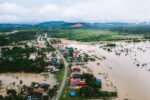Deadly Flooding and Extreme Weather: The Devastating Impact of Storm Hilary
Introduction
Storm Hilary, initially a hurricane, has brought unprecedented rainfall, flooding, and destructive winds to parts of the southwest and Mexico. The storm has transformed streets into raging rivers, caused power outages, and forced residents to evacuate or seek shelter. As the storm weakens, the aftermath is being cleaned up, but more rain is expected to fall, posing ongoing risks and challenges for affected communities. The extreme weather conditions brought on by Hilary have sparked urgent discussions about climate change and the need for effective disaster preparedness strategies.
The Records Broken
One of the most striking aspects of Storm Hilary is the record-breaking rainfall it has brought. Southern California experienced rainfall levels that shattered previous records. Palm Springs received nearly a year’s worth of rain in just 24 hours, and Death Valley nearly set a record with 1.68 inches. Nevada also witnessed historic rainfall, with the storm doubling the state’s 116-year-old all-time record. Lee Canyon in Nevada received a staggering 8.7 inches of rain, surpassing the previous record set in 1906.
Climate Change and Extreme Rainfall
The unprecedented rainfall brought by Storm Hilary raises concerns about the link between climate change and extreme weather events. While it is difficult to attribute a specific storm to climate change, scientists have long warned that global warming can lead to more intense and frequent extreme rainfall events. Warmer temperatures increase atmospheric moisture, leading to heavier rainfall. This pattern fits the description of what we are witnessing with Storm Hilary and other severe storms in recent years.
The Devastating Effects
The impact of Storm Hilary has been devastating, with floods causing damage to infrastructure, homes, and communities. Dangerous flash floods, mudslides, and debris flows have occurred in many areas, posing a significant threat to life and property. The storm has left tens of thousands of people without power and has disrupted emergency services. Evacuations and rescues have been necessary, highlighting the importance of effective disaster response systems.
Infrastructure and Climate Resilience
The damage caused by Storm Hilary underscores the urgent need for improved infrastructure and climate resilience measures. As extreme weather events become more frequent, it is crucial to invest in infrastructure that can withstand the impact of flooding and winds. Additionally, communities must have robust disaster response plans in place, including measures for timely evacuations and efficient emergency services. Climate change adaptation efforts should be a priority to protect vulnerable areas and ensure the safety of residents.
Lessons Learned and Future Preparedness
Storm Hilary serves as a wake-up call for communities and governments to reevaluate their disaster preparedness strategies. The storm has exposed vulnerabilities in infrastructure, emergency response systems, and public awareness. Governments and local authorities should take this opportunity to reassess their disaster management plans, allocate sufficient funding for climate resilience, and educate the public about the risks and precautions associated with extreme weather events.
Community Resilience and Climate Education
In addition to government action, building community resilience is vital in the face of climate change and extreme weather events. Communities should organize educational programs on climate change and its potential impacts, empowering individuals to take action to mitigate and adapt to these challenges. This includes promoting sustainable practices, such as reducing carbon emissions and conserving water resources. By working together, communities can build resilience and ensure their safety in the face of future storms.
Editorial: Addressing Climate Change and Investing in Resilience
Leveraging Storm Hilary to Drive Climate Action
Storm Hilary’s devastating impact should serve as a rallying cry for immediate action to address climate change. As extreme weather events become more frequent and severe, the urgency to reduce greenhouse gas emissions and transition to renewable energy sources becomes imperative. Governments and international bodies must prioritize climate action and allocate resources to research, development, and implementation of renewable energy technologies. Additionally, global cooperation is necessary to create comprehensive policies that tackle climate change holistically and ensure a sustainable future for all.
Investing in Resilience: The Cost-Benefit Analysis
Investing in climate resilience may seem costly in the short term, but the long-term benefits far outweigh the costs. By building infrastructure that can withstand extreme weather events and implementing effective disaster management systems, communities can save lives, reduce property damage, and minimize economic losses. Furthermore, resilient communities are better equipped to attract investments and promote economic growth. Governments, businesses, and individuals all have a role to play in investing in resilience measures and ensuring a sustainable and secure future.
Advice for Communities in the Face of Extreme Weather
Stay Informed and Prepared
In the face of extreme weather events like Storm Hilary, it is crucial to stay informed about weather updates and heed warnings from local authorities. Regularly monitor official sources of information, such as the National Weather Service or local emergency management agencies, for updates on the evolving situation. Have an emergency preparedness kit ready, including essential supplies, food, water, medications, and important documents.
Follow Evacuation Orders and Seek Shelter
If authorities issue evacuation orders, it is essential to follow them promptly and calmly. Evacuation orders are issued for your safety and should be taken seriously. Identify safe shelters in your area, such as community centers or designated evacuation centers, and make arrangements to reach them if necessary. Stay in contact with friends, family, and neighbors to ensure their safety and well-being during extreme weather events.
Support Climate Action and Resilience Efforts
As individuals, we can contribute to addressing climate change and building climate resilience in our communities. Support initiatives and organizations working towards renewable energy solutions, conservation efforts, and climate education. Advocate for climate action at the local, national, and international levels by engaging with policymakers and participating in discussions on climate change. By coming together, we can create a safer and more sustainable future.
Conclusion
Storm Hilary serves as a stark reminder of the profound impact of extreme weather events and the urgent need to address climate change. It is vital that we take immediate action to reduce greenhouse gas emissions, invest in climate resilience, and prioritize disaster preparedness. By doing so, we can protect our communities, minimize the damage caused by extreme weather, and create a more secure and sustainable future for all.

<< photo by Vinícius Henrique Photography >>
The image is for illustrative purposes only and does not depict the actual situation.
You might want to read !
- Climate Change Brings More Intense Tropical Storms: The Arrival of Hilary Reveals Vulnerabilities in California’s Infrastructure
- Austin-area Wildfire Engulfs Apartment Building, Spurring Emergency Response and Highlighting Climate Change Impact
- “Jamie Lee Curtis: The Raw Fear of Climate Change”
- A Meditative Experience: Captivating Sunsets and Blissful Encounters with Goats
- The Rising Threat to Small Business Owners: Investigating Laura Ann Carleton’s Tragic Death
- Rethinking the Title: The Uncertain Future of Mason Greenwood at Manchester United
- The Enigma of Michael Jordan: Silence Amidst Larsa Pippen’s Revelations
- “Biden’s Strategic Move: Elevating the Japan Summit Through Camp David”
- “Unveiling the Real Story: Assessing Michael Oher’s Alleged ‘Shakedown’ Attempt”
- Hope for Lake Mead: Hilary’s Rainfall Boosts Water Levels
- A Wet Relief: Hilary Delivers Much-Needed Boost to Lake Mead’s Water Level
- “Tropical Storm Hilary Approaches Southern California: Is the West Coast Prepared for Extreme Weather?”
- Why Laura Ann Carleton’s Fight for Freedom Demands that We Fly the Pride Flag High




